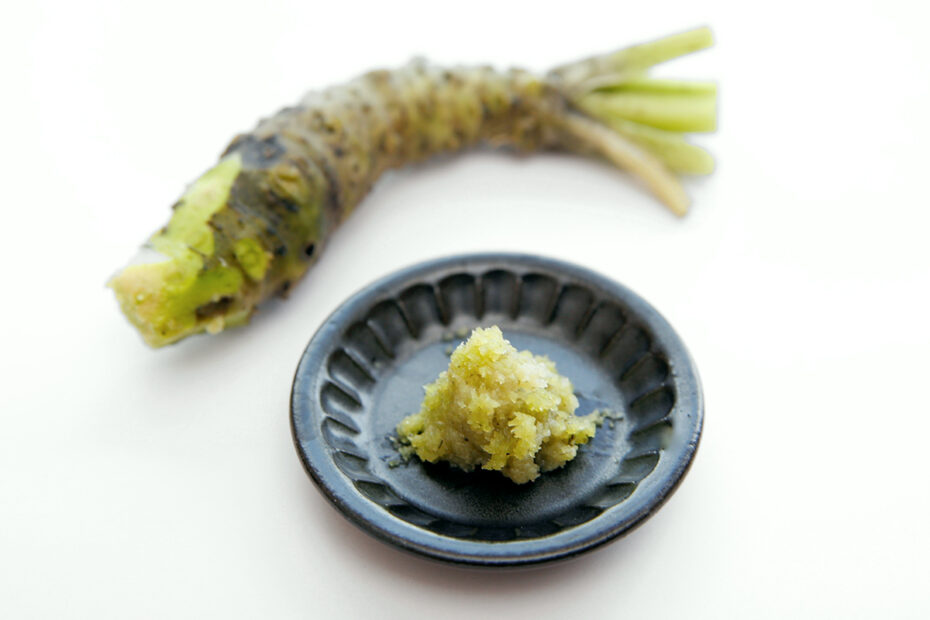Level up your sushi IQ with this spicy wasabi guide. Learn about real and fake wasabi, flavor, cultivation, and more.
What is Wasabi?
Wasabi is a perennial plant in the mustard family. Its stem (rhizome) is a popular sushi ingredient when ground to a paste. Wasabi is famous for its green color and crisp, spicy flavor. This heat only lasts momentarily and then transitions into sweetness.
Most sushi restaurants serve a wasabi imitation made from horseradish and green food coloring. The reason for the substitution is the high price of real wasabi.
Real vs Fake Wasabi
There are varying shades of wasabi on the market. This ranges from paste ground from a fresh rhizome to Western-style manufactured products consisting of horseradish and green food dye.
Most of the “wasabi” on the market isn’t 100% authentic wasabi paste. Horseradish, mustard, shoyu (soy sauce), and green food coloring are common ingredients.
There are packaged wasabi products on the market that contain no actual wasabi. But many brands are made with a varying amount of actual wasabi. The more that’s used, the more the package will likely say so.
Fresh, whole wasabi rhizomes can be found online and at specialty grocers.
Types of Wasabi
There are about 20 varieties of wasabi in Japan, most of which are regionally specific. The most prominent cultivars are Daruma, Mazuma, and Matsumura.
Daruma dominates in North America and perhaps Japan. It has a mild heat, a sweet finish, and a moist consistency.
Mazuma is also high quality, but it’s hard to find. That’s because it doesn’t have a consistent appearance and quality for the market. But it delivers a hot, savory flavor with a slightly sweet finish.
There’s also a long list of other high-quality types of wasabi. This includes Fuji Daruma, Izawa Daruma, Mochi Daruma, and Ozawa Daruma. Shimane Zairai is a brownish variety with a sticky texture and excellent quality. Also of note: Izuma, Shizukei 12 and 13, Sugita 25, Kamogiko 13, Sanbe, and Sabumi.
Let me know in the comments below if you want me to expand on this section.
What Does Wasabi Taste Like?
Freshly-ground wasabi tends to be aromatic, pungent, slightly spicy, sweet, and savory. There are differences in flavor between the different types of wasabi, but they’re generally all complex and flavorful.
Fresh wasabi is not nearly as hot as the bright green horseradish-based stuff.
I’ve heard a lot of people complain about this over the years. But price and rarity do not equate to spicier, most of the time.
Your everyday imitation of wasabi is spicier. But it doesn’t have much flavor or balance.
But to be fair, “fake” wasabi is ok too. Its low price and high spice are a great combo.
Wasabi Leaves
Wasabi leaves are not only edible, but they’re also delicious. They are similar to mustard greens: faintly spicy, vegetal, herbal, and crunchy.
One of the benefits of growing wasabi is the regular harvest of leaves.
Famous Food with Wasabi
For most Westerners, wasabi is part of their sushi ritual. An appropriate amount is added to a dish with soy sauce. Then pieces of sushi rolls are dunked in the mixture. This is totally appropriate. But test the wasabi to see how hot it is first.
High-end Edomae sushi restaurants often smear wasabi under nigiri before serving. In this case, additional wasabi isn’t necessary. Quality wasabi is also often placed on raw uni and ikura. It’s also common to find wasabi in chirashi sushi.
Beyond sushi, wasabi is frequently served with soba noodles and udon. Takowasa and wasabi pickles are two classic wasabi-based dishes worth trying.
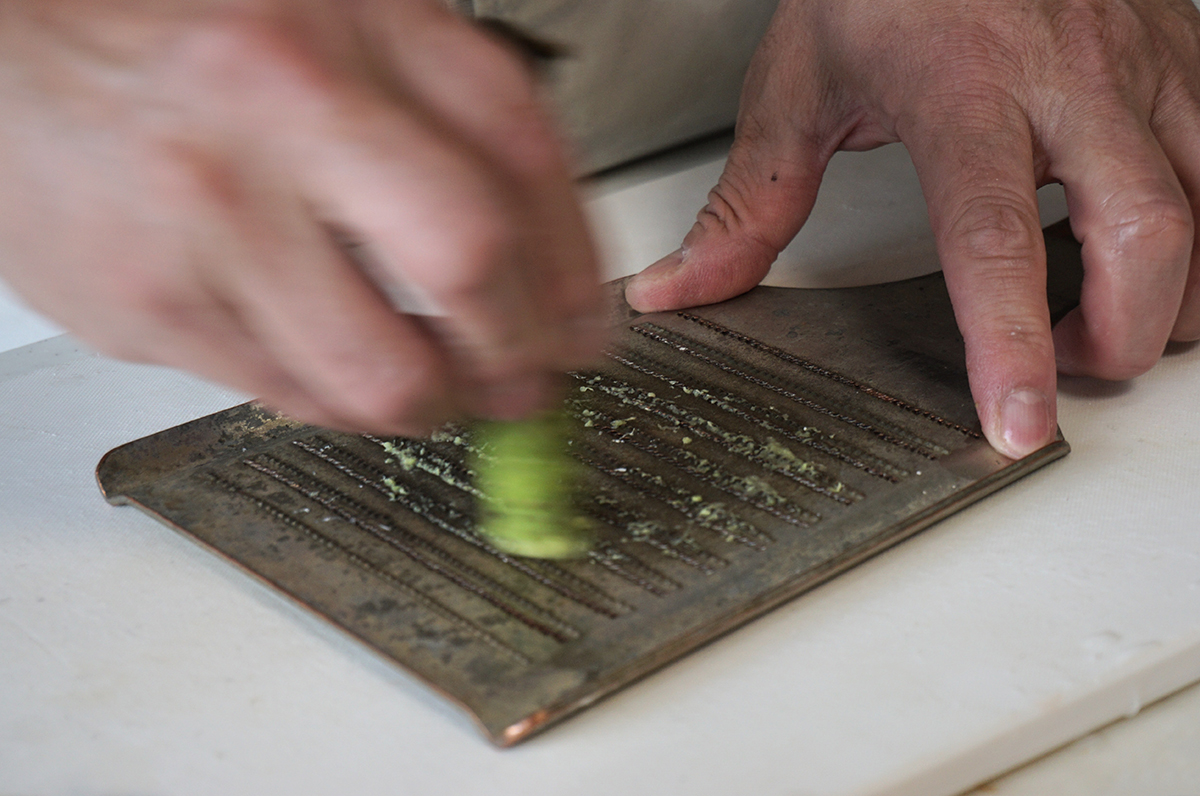
Serving Wasabi
Most packaged wasabi is ready to serve immediately. You can mix it into your soy sauce or pinch chunks onto your sushi as you eat.
A whole, fresh wasabi rhizome needs prepping first. All leaves and stalks must be removed. And after that, the wasabi is ground into a paste.
The traditional way to grate wasabi is with an oroshigane (or oroshiki). It’s a relatively small grader made of wood or metal with fine teeth. The coarse material is sometimes made with sharkskin. But metal is probably more common today for ethical reasons.
Buying Wasabi
Packaged, grated wasabi is widely available at grocers. Higher quality brands can be found in specialty grocers and some Asian markets. And there are tons of options online.
If you’re looking for whole wasabi rhizomes, your best bet is likely online. Prices per ounce range from $7-12 for US-grown Daruma wasabi. Imports from Japan might cost double that amount.
Oregon Coast Wasabi offers some of the lowest prices I could find in the US. But there are other grower-suppliers of whole fresh wasabi.
Why is Real Wasabi So Expensive?
The short answer is that wasabi can be hard to grow. But of course, it’s not quite that simple.
Wasabi does require a fairly narrow range of (cool) temperatures, high humidity, fresh oxygenated water, and shade. But if the conditions are right, it’s a fairly forgiving plant to grow. One issue though, is that it takes between one and two years for a plant to produce a full-sized rhizome. There’s a long window for problems to arise that might jeopardize the plant.
Another issue arises from the steep terrain wasabi is often grown. This requires much of the day-to-day work to be performed by hand, adding labor costs.
Recently, global warming has made previously ideal sites less so. And heavier and more frequent typhoons have been catastrophic in some locations. An unusually severe typhoon in 2019 significantly impacted wasabi production in Japan.
But a longer trend is Japan’s increasingly old population. Younger people often leave the rural areas for cities, further eroding the supply of workers. Simply put, fewer people are available to grow wasabi than in years past.
Drinks and Wasabi
Wasabi’s spice can be mitigated and its flavor enhanced with the right drink pairing.
To balance heat, pair wasabi with sparkling or semi-sweet sake, Moscato d’Asti, dryish riesling, and demi-sec chenin blanc.
Daisy-style cocktails with an extra dash of sweetness are also a good match for wasabi’s spice. Examples include margaritas, lemon drops, daiquiris, and cosmos.
Finally, malty semi-sweet beer and wasabi can be great partners. Irish red ale, dunkel, and Marzen are a few such beers. They combine smooth malt sweetness with restrained hop bitterness. It’s an ideal foil for a big dose of wasabi.
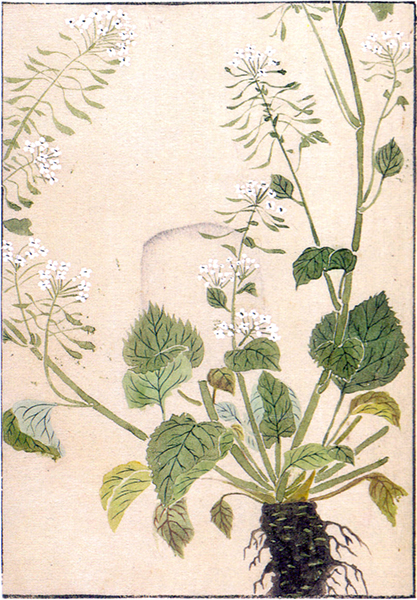
Taxonomy, Ecology, and Distribution of Wasabi
Wasabia japonica
Wasabi (Wasabia japonica) is in the Brassicaceae family. Close relatives include various species and cultivars of mustard, cabbage, kale, turnip, radish, and horseradish.
Native Range
Wasabi is native to eastern Asia. This includes Japan, the Korean Peninsula, and eastern Russia (Kamchatka and Sakhalin Island).
Within Japan, the top three growing prefectures (by volume) are Nagano, Shizuoka, and Iwate. Other prefectures growing large volumes of wasabi include Shimane, Yamaguchi, Kochi, and Oita.
Where It’s Grown Today
The demand for wasabi in Japan and abroad is too high for one country to meet.
Today, the plant is grown across the globe. Wasabi is grown commercially in South Korea, Taiwan, Thailand, New Zealand the United States, Canada, and Iceland.
North American wasabi cultivation is primarily in western parts of Oregon, Washington, and British Columbia. But eastern states like North Carolina and Tennessee are also producing this delicacy.
Climate Change and Wasabi
Wasabi requires cool temperatures, humidity, and plenty of oxygenated water to thrive. And this means it’s often cultivated in places at risk of heavy flooding. Extreme rain events are growing more common and washing away plants. A powerful typhoon in 2019 devastated Japan’s wasabi output.
The volatile weather is partially the result of rising temperatures. And heat can be deadly for wasabi.
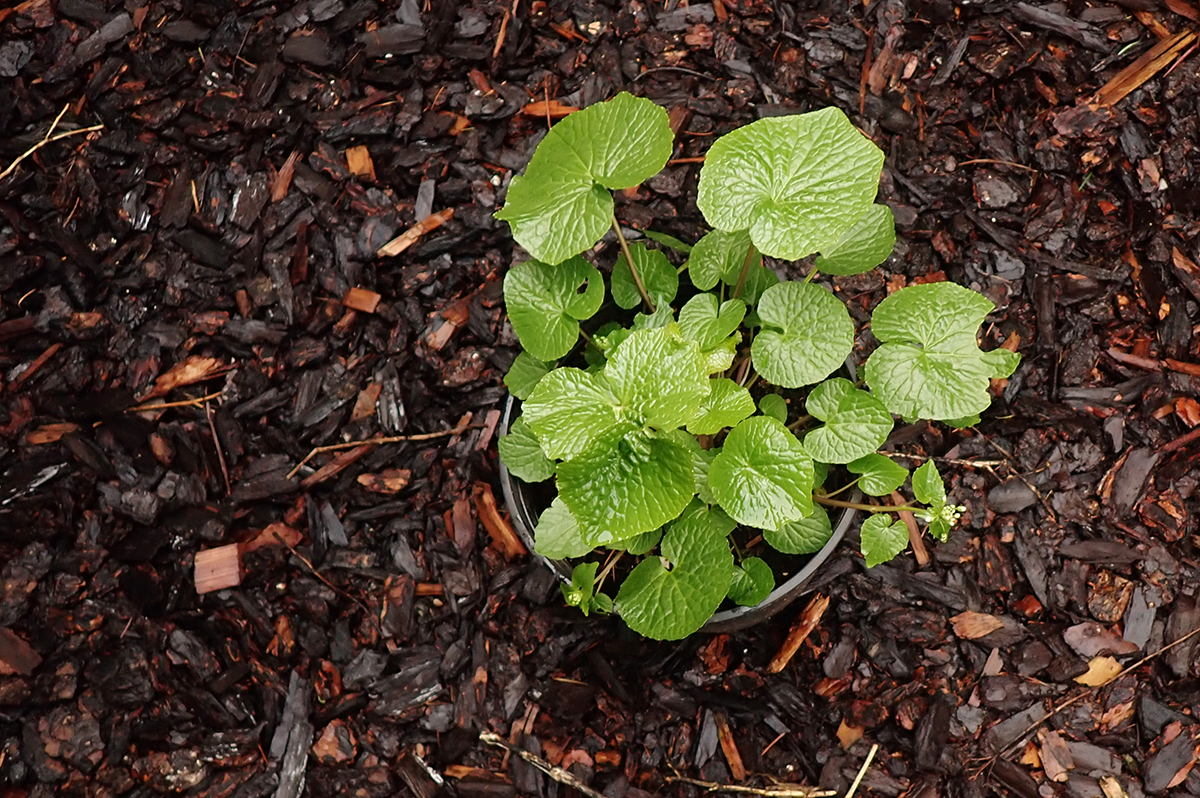
Cultivating Wasabi
As mentioned earlier in this post, wasabi has a relatively narrow band of conditions it tolerates. It grows naturally in mountainous creek valleys with lots of trees, fresh cold water, free-draining soil, high humidity, and shade.
Cultivating wasabi commercially or at home is possible if these conditions are mimicked. Plants must be kept in cool, full-shade conditions and occasionally fertilized.
Wasabi grows from the fall through the spring, but in the summer it slows down. Freezing temperatures can be bad for wasabi too, especially when prolonged.
Check out the Umami Garden video below if you’re curious about growing wasabi at home.

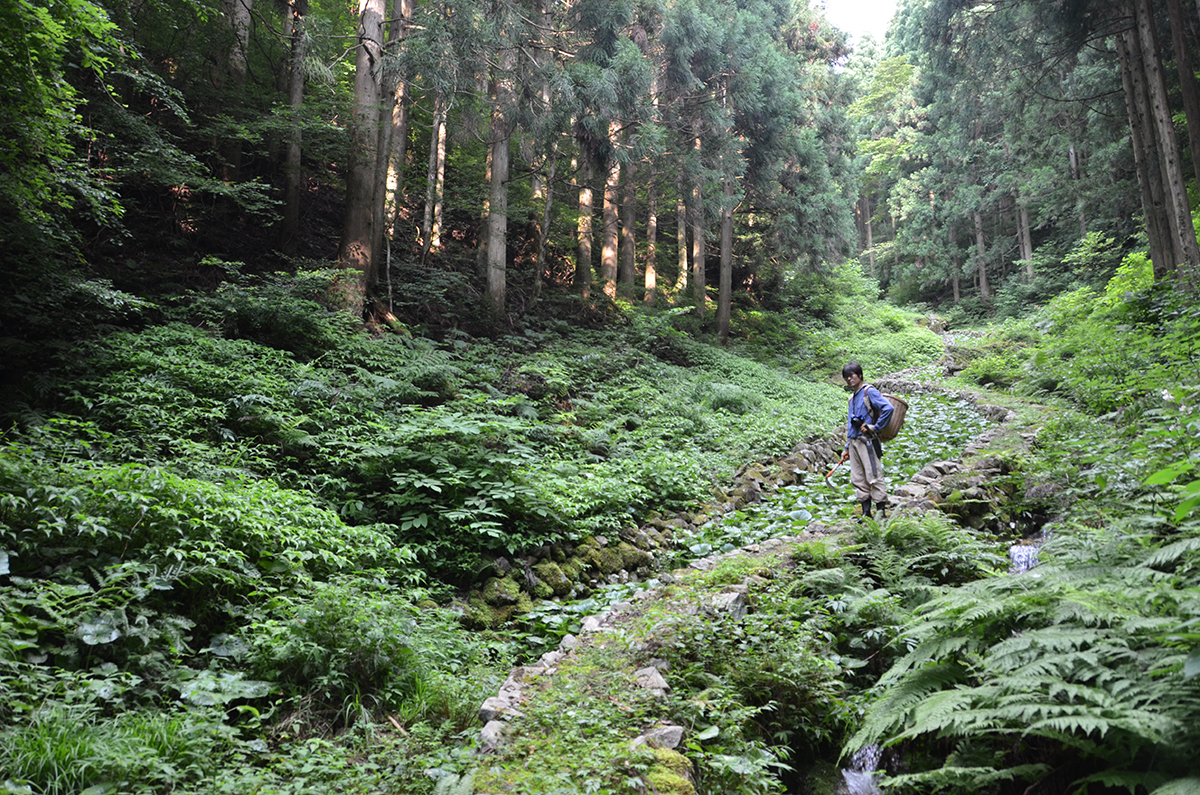
Traditional Methods
Wasabi cultivation began in the early Edo period around the year 1600. Numerous methods of cultivating wasabi developed in Japan over the centuries. But today, there are five main styles: Jizawa, Tatamishi, Hokusun, Keiryu, and Hirachi.
Among these, the Tatamishi style tends to yield the most and highest-quality wasabi.
If you want me to dive deeper into this topic, let me know in the comments below.

Brad Smith
I fell in love with Japanese cuisine nearly two decades ago and soon landed my first Japanese restaurant job. Many years later, I created this site to geek out on Japanese food and beverage.
I love learning and my professional certifications include the J.S.A. Sake Diploma, Certified Sommelier (CMS), Certified Sake Advisor (SSA), Certified Shochu Advisor (SSA), Certified Specialist of Spirits (SWE), and Certified Beer Server (CCP).
Check out my about page to learn more.
